Panasonic Lumix DMC-GM1 Review
Panasonic Lumix DMC-GM1 Introduction
The Panasonic Lumix DMC-GM1 is a miniature mirrorless camera. It is the smallest and lightest with a 2X or lower FLM and features a 16 MP LiveMOS sensor with a sensitivity range from ISO 125 to 25600. It can record full 1080p HD video at 30 FPS and images at 5 FPS.
Size is the key feature of the GM1 and Panasonic has made an incredible technological achievement by fitting a Four-Thirds sensor into a body the size of a compact camera. It is not much larger than the 3" LCD on its back yet maintains full manual-controls and a number of external controls.
The Panasonic GM1 offers plenty of advantages over compact cameras. Most notably, interchangeable lenses. With a small collapsible lens, the GM1 stays smaller than the majority of premium cameras which do not offer this flexibility. It has access to the full lineup of Micro Four-Thirds lenses.
Despite its diminutive size, the GM1 includes a traditional mode-dial, a single control-dial, customizable buttons and a built-in popup flash. It takes standard SDXC cards and a small proprietary battery which brings its weight to a mere 204g, plus lens. Panasonic ships it with a small and versatile 12-32mm F/3.5-5.6 stabilized lens.
This digital camera review analyses the usability, image quality and performance of the Panasonic Lumix DMC-GM1.
Panasonic Lumix DMC-GM1 Features
Sensor
- 16 Megapixels CMOS Four-Thirds sensor
- 2X Crop-Factor, 4:3 Aspect-Ratio
- Micro Four-Thirds lens mount
- Built-in Dust-Reduction
Exposure
- ISO 125 - 25600
- Intelligent & Standard Auto ISO
- Customizable Auto ISO Limit, 400 - 25600
- 1/16000 - 1s Electronic-Shutter
- 1/500 - 60s Mechanical-Shutter
- PASM Exposure modes with Program-Shift
- Multi-Segment, Center-Weighed and Spot metering
- Exposure-Compensation, ±5, 1/3 EV increments
- AEB, 3 - 7 frames, 1/3 - 1 EV increments
- Forced, Redeye, Slow-Sync, Slow-Sync Redeye, Off flash modes
- Flash-Compensation, ±2, 1/3 increments
- First or second curtain Flash-Sync
Image Parameters
- Automatic, 5 presetsSunny, Cloudy, Shade, Tungsten, Flash, Kelvin and 2 Custom White-Balance memories
- White-Balance Fine-Tuning, 19 steps, 2 axis
- WB Bracketing, 3 frames, 3 step sizes, 2 axis
- Adjustable Contrast, Sharpness, Saturation and Noise-Reduction, 11 steps each
- 5 Color and 1 B&W modes
- sRGB or Adobe RGB color spaces
Drive
- 5 FPS Mechanical-Shutter drive without preview
- 10 FPS Electronic-Shutter drive without preview
- 4 FPS Drive with preview
- Maximum 7 RAW files per burst
- 40 FPS Drive @ 4 MP, Max 39 JPEG
- Self-timer, 2s, 10s or 3 shots @ 10 seconds
- Interval-Timer, 1 - 9999 frames, 1s to 100 minute interval, immediate or delayed start
- Multiple-Exposure, 3 frames
- Automatic HDR, Auto or 1 - 3 EV steps
- Optional Auto Gain for Multiple-Exposure
- Optional Auto Align for HDR capture
Focus
- Single-Shot autofocus (AF-S), continuous autofocus (AF-C) or manual-focus (MF)
- Pinpoint, Center-point, 23-Points, Tracking and Face-Detect contrast-detect autofocus
- Optional DMF
- Optional Quick autofocus
- Optional MF-Assist
- Optional AF-Assist Lamp
Display
- 3" Touchscreen LCD, 1 megapixel
- Optional Live-Histogram
- Optional Blinking-Highlight
- Optional Framing-Guidelines, 3 types
- Optional Focus-Peaking, 2 levels
- Adjustable brightness, 7 steps
- Adjustable saturation, 7 steps
- Adjustable color, 11 steps, 2 axis
Output Processing
- 3:2, 16:9 & 1:1 Cropped aspect-ratios
- 12, 8 and 4 Megapixels mode
- JPEG, RAW, RAW+JPEG capture
- 2 JPEG Compression qualities
- Optional Long-Shutter Noise-Reduction
- Optional Vignetting Correction
- Optional Contrast Enhancement, 3 levels
- Optional Resolution Enhancement, 4 levels
- Optional Face-Recognition
Video
- 1920x1080 @ 30 FPS MPEG-4
- 1920x1080 @ 60i FPS AVCHD
- 1280x720 @ 60 FPS AVCHD
- Built-in stereo microphone
- Audio Input-Gain, 4 steps
- Optional Audio-Meter, 2 channels
- Optional Wind-Filter
Connectivity
- HDMI (1080i) output
- USB 2.0 connectivity
- WiFi (802.11b/g/n)
- NFC-F (ISO/IEC 18092)
Misc
- Single control-dials
- Traditional mode-dial
- One customizable button
- Lithium-Ion battery
- SDXC memory
Panasonic Lumix DMC-GM1 Usability - How easy is it to use?
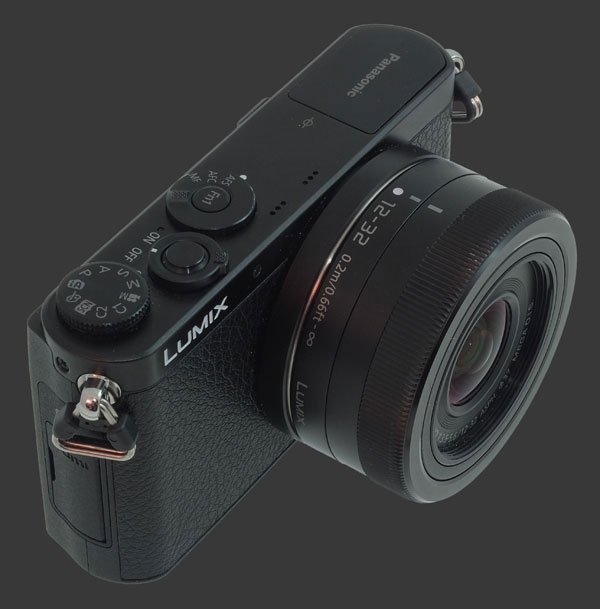
The Panasonic Lumix DMC-GM1 is unbelievably small for a mirrorless. Its clever body shape using a protruding lens mount makes it look even smaller than it actually is. Regardless, this camera is the size of a typical compact and yet very few cameras this small have manual-controls. This is both a source of awe and compromise.
The rectangular body offers no grip at all, just a flat and slightly-textured surface, making this camera precarious to hold. As with other mirrorless cameras, it is expected to be held with two hands, so there is less risk of it falling. An eyelet on each side allow the use of the supplied neck-strap, but one would probably use a wrist-strap instead with such a small camera.
Given how short the body is, one ends up with a cramped two-finger hold on the front. This is similar to compact cameras and is not meant for prolonged use. Still, the GM1 is incredibly light and will not be tiresome without a bulky lens attached. With the 12-32mm F/3.5-5.6 OIS kit-lens, it is a truly feather-weight while offering far better image-quality than any similarly-sized offering.
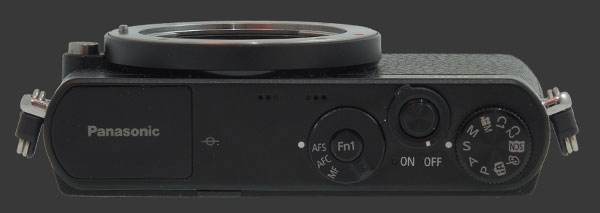
The top plate of the GM1 is utilitarian. At the left, we can see the top of a small built-in flash. After a tiny bit of free space, there is a stereo microphone, right against a combined rotating autofocus switch and customizable button. The switch rotates between 3 positions for AF-S, AF-C and MF modes. Since there is no direct ISO button on this camera, Fn1 should be configured to control sensitivity. There are 32 additional options to choose from though!
The shutter-release is found, surrounded by a rotating power-switch, further to the right. It has short amount of travel and a soft halfway point. This makes it less likely to shake the camera during exposure but increases the possibility of misfiring. At the edge of the top-plate, there is a traditional mode-dial. The ubiquitous PASM modes are all there, plus a fully automatic mode, a Filter mode, a position to groups all Scene modes, two customizable modes and a dedicated Video mode.
The Video mode in particular is very welcome as it allows to accurately preview video-framing, which is not the case on all modern digital cameras. The Panasonic GM1 is very capable for video. It offers full manual-controls, where the exposure-mode is selected in the menu, and processing parameters which are separate from stills.
All rotating controls on the top-plate have strong detents to prevent accidental changes. The mode-dial is also textured to provide a good grip which makes it usable with thin gloves. The focus switch, on the other hand, is smooth with only a small protrusion for purchase.
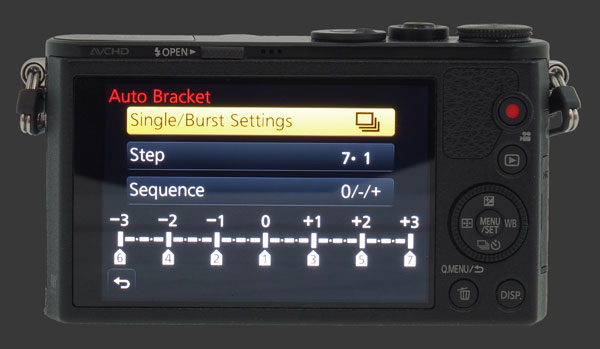
All remaining controls are located on the back of the camera which is dominated by a large 3" touchscreen LCD. The display is bright and, at 1 megapixel of resolution, extremely sharp. Unfortunately, it is not Exposure-Priority except in Manual exposure-mode and only when the Constant Preview option is enabled from the Custom setting menu. At least it shows 100% coverage and previews WB correctly though.
The touchscreen feature can thankfully be disabled. While it provides access to more customizable features, the screen is so close to the control-dial that it constantly gets inadvertently triggered. For some unknown reason, it remains active in Video mode. We can only guess that it is to avoid pressing buttons which may affect the sound-track or shake the camera.
To the right of the LCD, there is room for about half-a-thumb next to the Video-Record and Playback buttons. Both of these are slightly recessed from the camera surface to prevent accidental use which also makes them unusable with gloves on. The Video-Record button can be disabled but not reconfigured to anything else. The Playback one works just as usual.
Just below, there is a 4-way controller with central MENU/SET button. Each direction is assigned a dedicated function:
- Up: Toggles EC, except in Manual mode where it switches between Aperture and Shutter-Speed.
- Right: Selects White-Balance. The screen which appears when Right is pressed is also used to fine-tune white-balance or enable WB bracketing.
- Down: Selects a drive mode: Off, Single-Shot, ContinuousSuper-High Speed (40 FPS @ 4MP), High-Speed (10 or 5 FPS) without preview, Medium Speed (4 FPS) or Low speed (2 FPS), Bracketing and Self-Timer2s, 10s or 3-frames at 10s. There is no difference between Off and Single-Shot as far as we can tell.
- Left: Selects the AF mode: Pinpoint, Single-Point, Automatic 23-Area, Tracking and Face-Detect. The focus point or area, depending on the mode, can be set by pressing Down fro there. Pinpoint allows the selection of an exact point while Single-Point allows the selection of an image-area. Four area-sizes are available.
Around the 4-way controller, there is an extremely thin control-dial. This is the only one on the GM1 and is rather flimsy. In Capture mode, it controls the active exposure parameter. In Playback mode, it magnifies images. It can also be used to navigate the menu. The control-dial has soft detents and is ribbed to provide some grip. This is insufficient for use with gloves on.
Along the lower-edge of the camera, there are two more buttons. One is Q.MENU which brings up 2 rows of icons to set some photographic controls. The same button is used to back-out of sub-menus and to delete images and videos, depending on the context. The other button, DISP, cycles over display modes in Capture and Playback.
There are quite a few display options on the GM1. A 2-Axis digital level overlay is available. It is accurate, easy to see and unobtrusive. Exactly how it should be! There is a MF Assist function which magnifies part of the frame to full-screen or PIP to keep an eye on framing. Focus-Peaking can optionally be enabled.
There is a Live-Histogram which sadly shows the display distribution instead of being based on exposure. One of 3 types of framing guidelines can be enabled, as well as blinking highlights. These last ones do not appear to be accurate either.
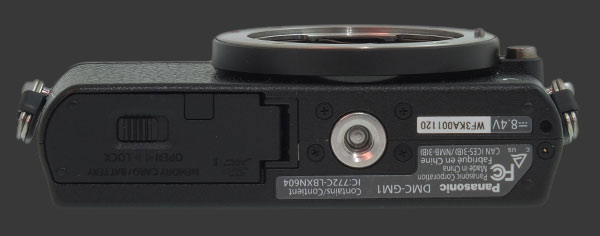
The bottom of the camera features a metal tripod mount which is perfectly aligned with the optical axis. There is also a rather flimsy plastic door which covers the combined battery and memory-card compartment. The unusual thing to note about here is that the lens mount is flush with the base of the camera. Since the camera is so thin, this makes it difficult to zoom while the camera is mounted on a quick-release plate which causes friction against the lens ring.
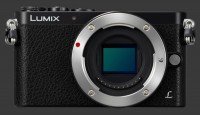 |
Please Support Neocamera
All information on Neocamera is provided free of charge yet running this website is a huge endeavor. Purchases made via affiliate links found throughout the site help keep it running and up-to-date. There is no additional cost to you, so please consider buying via these links to our affilates:
Thank you for your support!
Panasonic DMC-GM1 Highlights

Sensor-Size: 17 x 13mm

Actual size when viewed at 100 DPI
| 16 Megapixels Mirrorless | ISO 125-25600 |
| Micro Four-Thirds Mount 2X FLM | Shutter 1/16000-60s |
| 2 Axis Digital Level | Full manual controls, including Manual Focus |
| Built-in Dust Reduction | Custom white-balance with 2 axis fine-tuning |
| 5 FPS Drive, 7 Images | Spot-Metering |
| 1920x1080 @ 30 FPS Video Recording | Lithium-Ion Battery |
| 3" LCD 1 Megapixels | Secure Digital Extended Capacity |
Updates
2025.11.13

Best Gifts for Photographers in 2025 by Budget
The annual Neocamera Photography Gift Guide updated to 2025. Find great gifts for photographers with any price budget.
2025.07.07

Stellar Photo Recovery Review
Review of Stellar Photo Recovery V12. This Windows and MacOS software can recover photos and videos in a huge number of formats from memory cards, USB drives, SSDs and HHDs.
2025.05.14

Huion Kamvas 13 Gen 3 Review
In-Depth review of the Huion Kamvas 13 Gen 3 Pen Display Tablet for photographers and graphic artists.
2025.01.18

Fujifilm GFX 2025 Lens Roundup
Lens Review roundup of Fujifilm GFX Medium-Format lenses. Quality, performance and handling of the GF20-35mm F/4R WR, GF30mm F/3.5 Tilt-Shift and the GF55mm F/1.7.
2024.11.18

Best 2024 Photography Gifts for Every Budget
Great gifts for photographers and photo enthusiasts selected for every budget among the best products of 2024.
2024.08.07

Eye Protection Tips for Professional Photographers
The four main considerations for professional photographers regarding eyewear.
2024.07.14

Fujifilm X100VI Review
Flagship fixed-lens compact digital camera with a 40 MP sensor and Image-Stabilization, a first for the series. Retro design featuring dual control-dials, plus direct ISO, Shutter-Speed and EC dials. Its hybrid viewfinder can switch between EVF and OVF mode.
2024.05.09

Fujifilm GFX100 II Review
Flagship 102 Megapixels Medium-Format Mirrorless Digital Camera with 8-Stop 5-Axis IBIS, 8 FPS Drive, 8K Video and 400 MP Super-Resolution capture in a weatherproof and freezeproof body with dual control-dials and dual memory-card slots.
2024.04.03

Fujifilm X-T5 Review
Newest Fujifilm flagship boasting a 40 MP APS-C sensor, 5-axis IBIS with 7-stop efficiency, 15 FPS continuous drive, 6.2K Video capture, dual control-dials and dual SDXC UHS-II slots in a sturdy weatherproof and freezeproof body.
2023.11.20

Best Digital Cameras of 2023
Find out which are the Best Digital Cameras of 2023. All the new Mirrorless Digital Cameras from entry-level to high-end professional.
2023.07.10

Fujifilm X-H2 Review
40 Megapixels APS-C Hybrid Mirrorless Digital Camera with 7-stop IBIS. Fastest shutter ever and 8K video capture. Large builtin EVF with 0.8X magnification and 5.8 MP, plus an Eye-Start Sensor. Packed with features and large number of controls in a weatherproof and freezeproof body.
2023.05.07

Sony FE 20-70mm F/4G Review
Review of the unique Sony FE 20-70mm F/4G lens. The optical zoom of this lens spans ultra-wide-angle and medium focal-length coverage, making it one of the most versatile Full-Frame lenses on the market.












